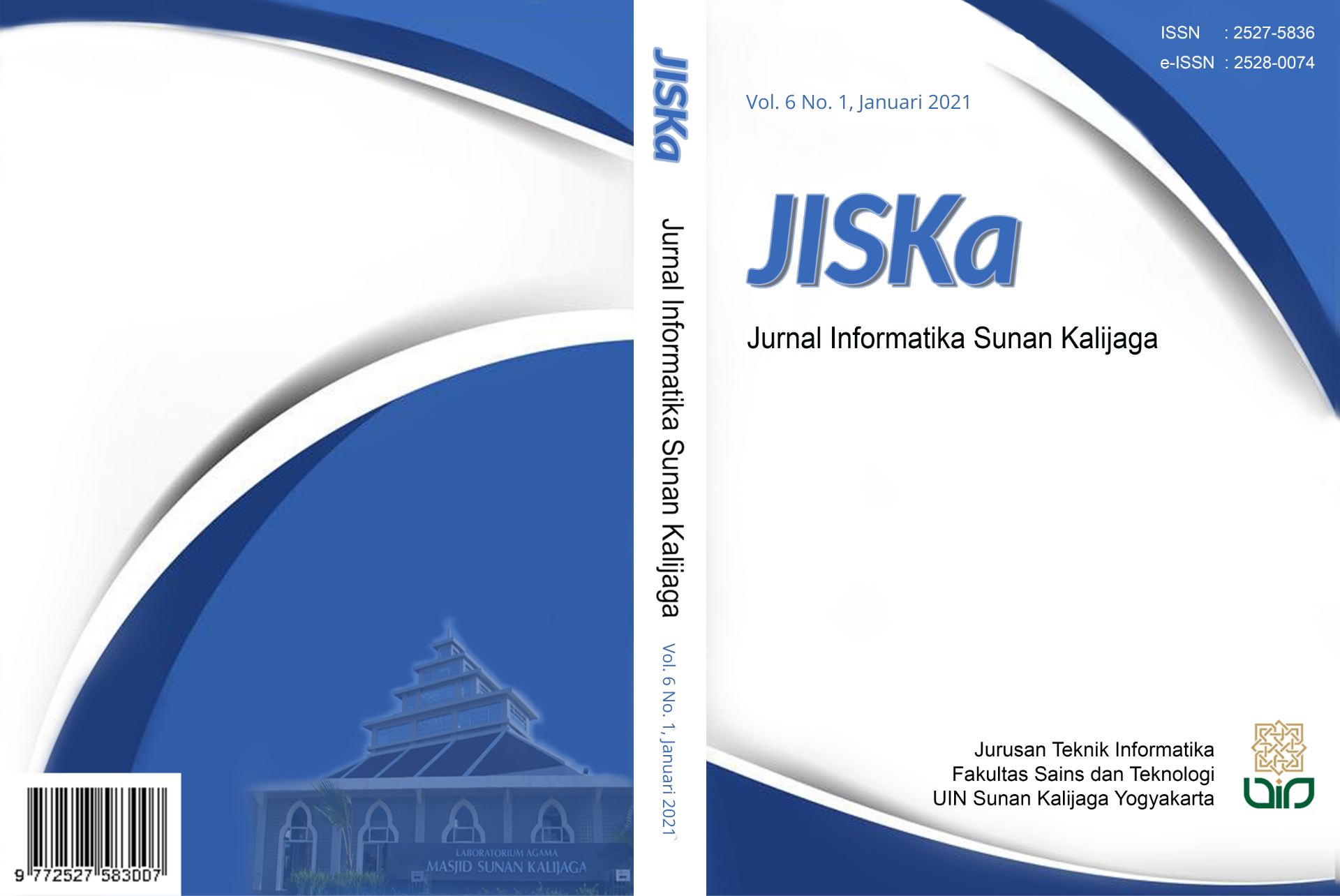Implementasi Closeness Centrality dalam Analisis Penyanyi Indonesia di DBpedia Indonesia
DOI:
https://doi.org/10.14421/jiska.2021.61-03Abstract
Indonesian singers have a diverse musical genre. They also origin from several regions in Indonesia. This study analyzes the relationships between singers, genre, and origin of the singer using the Closeness Centrality algorithm. Data are retrieved by using a SPARQL query on DBpedia Indonesia. The generated graph produces a density value of 0.01. The results of the Closeness Centrality calculation shows that more than 50% out of 268 singers had scores above 30%.References
Abele, A., McCrae, J. P., & Buitelaar, P. (2017). An Evaluation Dataset for Linked Data Profiling. Lecture Notes in Computer Science, 1–9. https://doi.org/10.1007/978-3-319-59888-8_1
Baek, S. I., & Bae, S. H. (2019). The Effect of Social Network Centrality on Knowledge Sharing. Journal of Service Science Research, 11(2), 183–202. https://doi.org/10.1007/s12927-019-0009-2
Bizer, C., Heath, T., & Berners-Lee, T. (2011). Linked Data: The Story so Far. In Semantic Services, Interoperability and Web Applications: Emerging Concepts (pp. 205–227). IGI Global.
Chen, J., Jiang, Y., & Yang, M. (2019). Collaborative Recommendation for Scenic Spots based on Degree Centrality. 2019 6th International Conference on Systems and Informatics (ICSAI), 611–615. https://doi.org/10.1109/ICSAI48974.2019.9010437
Gaharwar, R. D., & Shah, D. B. (2018). Use of Degree Centrality Principle in Deciding the Future Leader of the Terrorist Network. International Journal of Scientific Research in Science and Technology (IJSRST), 4(9), 303–310.
Gomes Jr., L., & Frizzon, G. (2019). Fake News and Brazilian politics – temporal investigation based on semantic annotations and graph analysis. XXXIV Simpósio Brasileiro de Banco de Dados, 169–174. https://doi.org/10.5753/sbbd.2019.8818
Grover, A., & Leskovec, J. (2016). node2vec: Scalable Feature Learning for Networks. Proceedings of the ACM SIGKDD International Conference on Knowledge Discovery and Data Mining, 855–864. https://doi.org/10.1145/2939672.2939754
Harris, S., Seaborne, A., & Prud’hommeaux, E. (2013). SPARQL 1.1 Query Language. W3C.
Kolesnikov, V., Anikin, V., Mosolova, E., Faizliev, A., Mironov, S., Zemlyanskaya, M., Pleshakov, M., & Sidorov, S. (2019). Food Chain Analysis Based on Graph Centrality Indicators. Journal of Physics: Conference Series, 1334, 1–11. https://doi.org/10.1088/1742-6596/1334/1/012004
Needham, M., & Hodler, A. E. (2019). Graph Algorithms: Practical Examples in Apache Spark and Neo4j (1st ed.). O’Reilly Media.
Perwiradewa, A., Rofiif, A. N., & Rakhmawati, N. A. (2020). Visualisasi Pemain Sepak Bola Indonesia pada DBPedia dengan menggunakan Node2Vec dan Closeness Centrality. Jurnal Buana Informatika, 11(2), 104–111. https://doi.org/10.24002/jbi.v11i2.3346
Rakhmawati, N. A. (2015). Semantic Web dan Linked Data (Yono (ed.); 1st ed.). Sibuku Media.
Rakhmawati, N. A. (2020). nurainir/Penyanyi-Centrality: submittojiska. https://doi.org/10.5281/ZENODO.3956065
Shaikh, M. A., & Jiaxin, W. (2006). Investigative Data Mining: Identifying Key Nodes in Terrorist Networks. 2006 IEEE International Multitopic Conference, 201–206. https://doi.org/10.1109/INMIC.2006.358163
Zhang, J., & Luo, Y. (2017). Degree Centrality, Betweenness Centrality, and Closeness Centrality in Social Network. 2017 2nd International Conference on Modelling, Simulation and Applied Mathematics (MSAM2017), 300–303. https://doi.org/10.2991/msam-17.2017.68
Downloads
Additional Files
Published
How to Cite
Issue
Section
License
Authors who publish with this journal agree to the following terms as stated in http://creativecommons.org/licenses/by-nc/4.0
a. Authors retain copyright and grant the journal right of first publication with the work simultaneously licensed under a Creative Commons Attribution License that allows others to share the work with an acknowledgement of the work's authorship and initial publication in this journal.
b. Authors are able to enter into separate, additional contractual arrangements for the non-exclusive distribution of the journal's published version of the work (e.g., post it to an institutional repository or publish it in a book), with an acknowledgement of its initial publication in this journal.
c. Authors are permitted and encouraged to post their work online (e.g., in institutional repositories or on their website) prior to and during the submission process, as it can lead to productive exchanges, as well as earlier and greater citation of published work.










